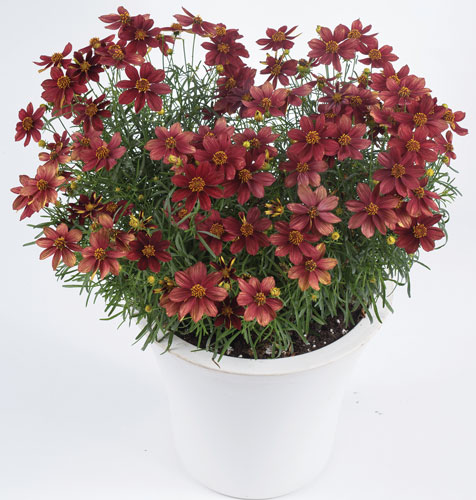11/1/2017
Simple Coreopsis Crop Culture
Mike Fernandez

As perennials continue to capture consumer interest—note the National Garden Bureau’s designation of 2018 as Year of the Coreopsis—we’ll continue to see development of creative new colors and stronger breeding in the category. With that increased focus, it becomes even more important to master great crop culture.
One of the newest introductions, Coreopsis Rossana from Danziger, offers large, rich red and dark yellow flowers and an easy-growing, low-maintenance nature that will appeal to both growers and end users.
It reaches 12 in. high and spreads to 14 in. With a beautiful, mounding growth habit and medium vigor, Rossana provides striking color from early spring through fall. Hardy in Zones 5 to 9.
Sticking
Stick one liner per cell, then follow with an application of Daconil fungicide on the day of sticking. Make a second Daconil application in Week 2. Always read and follow label instructions.
Planting
Transplant in Week 5, two plants per pot for 4.5-in. pots. Plants will be ready for spring sales in approximately 14 weeks.
Light intensity
Coreopsis Rossana prefers full sunlight to partial shade, or a minimum of 5,000 foot candles (fc) or 50,000 lux. Provide supplemental lighting through transplant in Week 5. Lighting is not needed to flower early, but will help in production of the liners in low light areas.
Temperature
Maintain greenhouse temperatures at 72 to 74F (22 to 23C) in Weeks 1 through 3. Beginning in Week 4 and for the remainder of the production cycle, decrease greenhouse temperatures to 62 to 65F (16 to 18C).
Fertilization
Rossana is a moderate feeder. Start with 50 ppm nitrogen in a mist for Weeks 1 and 2. Beginning in Week 3, feed 100 to 150 ppm and continue that rate through finish at Week 14.
Irrigation
Keep plants evenly moist. Do not overwater or root damage may develop.
Medium & pH
Use a well-drained, porous, disease-free potting mix. Maintain pH at 6.0 to 6.5 throughout production.
Electrical conductivity
Electrical conductivity (EC) should increase slightly as production progresses. Start with 0.80 in Week 1, then increase to 0.90 in Week 2. From Weeks 3 through 14, EC should be fairly steady at 0.90 to 1.0.
Pinching
Pinch once in Week 3, approximately 10 to 15 days after planting and establishing.
PGRs
Plan for a B-Nine/A-Rest tank mix spray application for the first time at Week 4 and again in Weeks 5 and 6. Drench with Bonzi in the finished container, if needed. Always read and follow label instructions.
Diseases & pest control
Preventive pest and disease management is the most successful approach with coreopsis and many other crops. Begin with a spray program at sticking and follow up as needed to target any hot spots.
Vigilant scouting and monitoring will be critical to prevent disease or insect activity during the production cycle.
Greenhouse conditions also play a key role in crop quality and vigor, starting with good sanitation and continuing by ensuring good air circulation and maintaining moderate humidity levels. Wet, stagnant conditions are good breeding grounds for both insects and diseases.
Tight spacing and overhead irrigation often contributes to botrytis development on coreopsis lower leaves. Preventive fungicide sprays, proper spacing and good airflow all go toward prevention.
In addition, powdery mildew can sometimes be an issue on coreopsis grown in cool, wet environments. If an outbreak occurs, consider spraying with a product such as Heritage, Pipron, Strike, Systhane (Eagle) or Terraguard. Always read and follow label instructions. GT
Mike Fernandez is North American Market Manager for Danziger “Dan” Flower Farm. He can be reached at
mike@danziger.co.il.